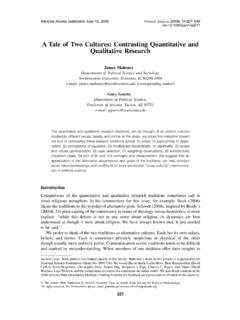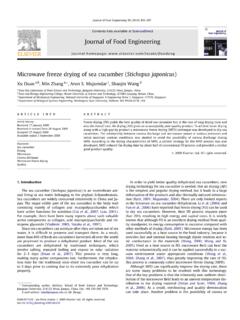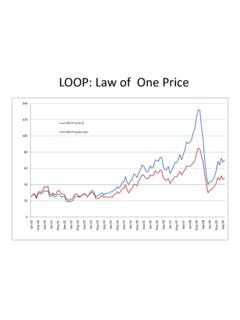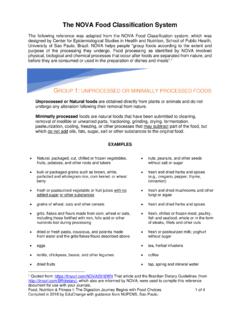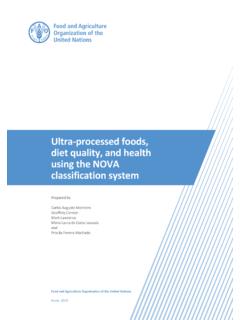Transcription of Introduction to Food Processing - Washington State University
1 Introduction to food ProcessingWhy process foods? 1. Prevent, reduce, eliminate infestation of food with microbes, insects or other vermin2. Prevent microbial growth or toxin production by microbes, or reduce these risks to acceptable levels3. Stop or slow deteriorative chemical or biochemical reactions4. Maintain and/or improve nutritional properties of food5. Increase storage stability or shelf life of food6. Make food more palatable and attractive7. Make foods for special groups of people1. Prevent, reduce, eliminate infestation of food with microbes, insects or other vermin1 - keep it clean2- keep 'em out3- kill 'em (if you can) Processing methods designed to keep foods clean: packaging (primary, secondary) cleaning (mechanical, chemical) milling grainProcessing methods designed to keep 'emout: packaging sanitation good manufacturing practicesProcessing methods designed to kill 'em: Thermal Processing commercial sterility 12D process for C.
2 Designed to kill only vegetative cells of pathogens, not sporesProcessing methods designed to kill 'em: Non thermal processes Radiationirradiation (gamma, ultraviolet) High pressure Processing Vegetative cells only Spores only if coupled with heatingProcessing methods designed to kill 'em: Chemical treatmentssanitizer chemicals, peroxides, acids, bacteriocins (nisin), controlled atmosphere Combinationsof heat, nonthermalprocesses, chemicals2. Prevent microbial growth or toxin production by microbes, or reduce these risks to acceptable levels- Processing methods- pasteurization freezing refrigeration2. Prevent microbial growth or toxin production by microbes, or reduce these risks to acceptable levels- Processing methods reduce water activity dehydration curing (high salt w/ or w/o nitrite) reduces water activity add sugar ( jams and jellies), gums or gels2.
3 Prevent microbial growth or toxin production by microbes, or reduce these risks to acceptable levels- Processing methods acidification including microbial fermentations biotechnology - natural pesticides (Bt), pesticide resistant plants ( Roundup resistant)2. Prevent microbial growth or toxin production by microbes, or reduce these risks to acceptable levels- Processing methods preservatives modified atmosphere packaging (carbon dioxide - inhibits S. aureus, Salmonella sp., Yersinia enterocolitica, E. coli, NOT C. botulinum) combinations of these3. Stop or slow deteriorative chemical or biochemical reactions Freezing food chemically active until 40oF Refrigeration slows but does not stop Dehydration Fermentation Genetic engineering ('Flavrsavr' tomato)3. Stop or slow deteriorative chemical or biochemical reactions-Additives Sulfiting agents Antioxidants, "antioxidant synergists Buffering agents Chelating agents Preservatives Enzymes (glucose oxidase/catalase) Sacrificial additives (added lysine, glucose)3.
4 Stop or slow deteriorative chemical or biochemical reactions Packaging exclude oxygen or reduce to 1-3%, exclude moisture & light modified atmosphere - inhibits spoilage organisms, limits oxidative reactions (including those affecting color) Combination of these3. Stop or slow deteriorative chemical or biochemical reactions Thermal Processing Non-thermal Processing (UHP) inhibits different rxns by different mechanisms than heating4. Maintain and/or improve nutritional properties of food thermal Processing (commercial sterility, pasteurization)- blanching w/ freezing- refrigeration enrichment or fortification (vitamins, minerals) 'nutrient enhanced' (added vitamins, mineral, protein, fiber)4. Maintain and/or improve nutritional properties of food genetic engineering ( high lysine corn) antioxidants, free radical scavengers and chelating agents packaging (exclude light, oxygen) combinations of these5.
5 Increase storage stability or shelf life of food - Processing - thermal Processing - refrigeration- freezing- dehydration-fermentation- curing and smoking5. Increase storage stability or shelf life of food - Preservatives- Antioxidants, free radical scavengers and chelating agents- Packaging- Combinations of these6. Make food more palatable and attractiveprocessing techniques- thermal Processing (to inactivate enzymes, modify texture, flavor, color)- freezing- refrigeration- dehydration-fermentation- curing and smoking- grain milling and grinding; flour6. Make food more palatable and attractive- hydrogenation of fat- functional additives- colorants including whitening agents- add components- flavorants- humectants- preservatives- antioxidants- packaging- combinations of these7.
6 Make foods for special groups of people- infant foods- geriatric foods ( Ensure)- nutraceuticals/ functional foods- ethnic foods- food service/institutional products- convenience foods- reduced calorie/fat/sodium foods


